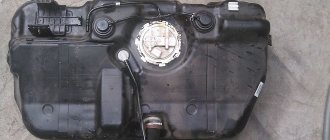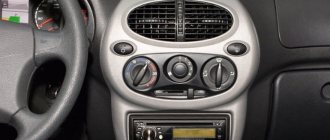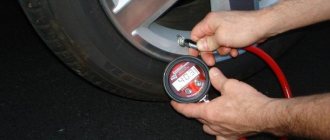In November 2004, the first series of the Lada Kalina people's car came off the assembly line of the AvtoVAZ concern. According to some reports, the first samples of small-scale production appeared on the market back in 1998. When production was established, the car began to be equipped in three body types: a 5-door hatchback and a sedan, and later a station wagon. The manufacturer's data indicates that the fuel consumption of the Lada Kalina is at an average level, which is confirmed by numerous reviews from owners. Subsequently, both the body and the power unit of this car were modernized, and today the second series of LADA Kalina is being produced.
Factory standard fuel consumption indicators for Lada Kalina
There are four main models of the Lada Kalina passenger car:
- sedan - has a closed body, with 2-3 rows of seats for the driver and passengers, the trunk is separated from the car interior, there is no lifting door in the rear wall;
- station wagon - has a closed cargo-passenger body, one of the sedan variants, which has an enlarged luggage compartment, is equipped with a lifting door in the rear wall;
- hatchback - has a body with 1-2 rows of driver and passenger seats, with a shortened rear overhang (hence the name - “hatchback” means “short”) and a smaller luggage compartment, equipped with a lift-up door in the rear wall;
- sport - is a sports version, which is equipped with a number of special parts - a bumper, an exhaust pipe tip, sports pedals, alloy wheels, a SAAZ Sport sports suspension, front and rear disc brakes, an original reinforced gearbox.
As you can see, the main difference between each model is its body type. Gasoline consumption (unleaded AI-95) is calculated in liters over a driving cycle, which is 100 kilometers.
In this case, the following parameters of the vehicle itself are taken into account:
- Engine size (Lada Kalina comes in two types - 1.4 l and 1.6 l).
- Number of valves (for Lada Kalina - 8 and 16).
Experts have prepared an information table that shows the factory fuel consumption indicators for each model of the Lada Kalina passenger car, taking into account the mandatory parameters.
| Model Lada Kalina | 1.6 l (8 valves) | 1.6 l (16 valves) | 1.4 l (16 valves) |
| sedan | 7,8 | 7,2 | 7,0 |
| station wagon | 7,3 | 7,2 | 7,0 |
| hatchback | 7,3 | 7,3 | 7,0 |
| sport | – | 7,8 | – |
The manufacturer sets the standards for digital fuel consumption indicators for each Lada Kalina model based on the results of test runs of passenger cars on a special track. But on the track, driving conditions are reduced to ideal, and the car is driven by an experienced driver. In real conditions, everything becomes much more complicated. In addition, the speed indicator during real driving is not always within the required limits - from 100 km/h to 120 km/h. This is due to the fact that some drivers do not recognize the established framework for optimal driving of a Lada Kalina car, which significantly affects fuel costs.
How to repair or replace an automatic transmission
Automatic transmission repair in the event of a breakdown is possible, but it is recommended to resort to it only with the help of real professionals. Repair or replacement of the robotic gearbox is carried out by many service stations, and at the same time they offer two options for possible repair of the unit.
| Type of repair | Work carried out |
| Partial | It is also called local repair of Lada Kalina automatic transmission. In this case, before carrying out repair work, the vehicle and gearbox are diagnosed, after which, if necessary, professionals begin dismantling the automatic transmission pan. If, based on the diagnostic results, a problem was found in the gearbox, the unit is removed and washed in a special bath. This procedure is intended to perform further troubleshooting through the use of the necessary spare parts and components. Upon completion of the work, the repaired gearbox is installed in place, and the pan is mounted to the car. |
| Capital | This option involves diagnostics, as in the first case, but the subsequent steps involve a complete replacement of the automatic transmission. Moreover, if the diagnostic results reveal sufficiently serious problems, specialists will not look for the cause of the malfunction, but will carry out a complete troubleshooting of the structure. In turn, a complete troubleshooting implies the replacement of all components and spare parts that have been diagnosed with the greatest wear. |
Real fuel consumption of Lada Kalina (according to reviews from car owners)
Many car owners of the Lada Kalina passenger car complain that in reality, gasoline consumption indicators differ from those specified by the manufacturer. For comparison, let’s look at another information table prepared by specialists taking into account feedback from Lada Kalina car owners.
| Terrain type | Lada Kalina, 1.4 l | Lada Kalina, 1.6 l | ||
| Fuel consumption (l/100 km) | Average (l/100 km) | Fuel consumption (l/100 km) | Average (l/100 km) | |
| Urban | 6,8-11,5 | 8,47 | 7,0-12 | 9,5 |
| Route | 5,0-8,5 | 6,18 | 5,6-9 | 6,8 |
| Mixed | 6,5-8,3 | 7,29 | 7,0-9,0 | 8,0 |
When comparing two information tables, it is clear that the real figures are indeed higher than the stated factory fuel consumption standards for the Lada Kalina. What are the reasons for this discrepancy between the figures?
The main reasons for the difference between the gas consumption figures for the Lada Kalina passenger car - real and factory ones
There are several reasons for the discrepancy between the actual gasoline consumption figures of the Lada Kalina and the factory standards. Experienced car enthusiasts identify typical ones among them:
- Type of terrain - driving in the city, on the highway, off-road or mixed type of road (the more complex the type of road, the higher the fuel consumption).
- The driver's driving style is slow driving, fast driving, with sharp acceleration, with sharp braking (the more complex the driving style, the higher the gas consumption).
- The quality of the fuel used - AI-95 gasoline is consumed less than AI-92 gasoline.
- Time of year - in winter, fuel consumption rates will be higher, this is affected by icing of the road surface and frequent warming up of the vehicle itself.
- Traffic jams - due to slow driving and frequent braking, gasoline consumption increases by almost several liters.
- Using additional car devices (for example, air conditioning) – with devices constantly on, gasoline consumption will be 0.5-1 liter more.
In addition to the reasons listed, fuel consumption can be affected by various breakdowns of the vehicle itself:
- incorrect readings of the electronic engine control system due to sensor errors - temperature, mass air flow, oxygen, throttle position;
- abnormal pressure in the fuel system;
- internal combustion engine injector malfunction;
- failure of the catalyst;
- dirty air filter.
To install them, the car owner needs to diagnose the Lada Kalina passenger car. After diagnosing and identifying the causes of malfunctions, the vehicle is repaired.
Source
New bodies and engines • Emur malfunctions
Its parameters may be outside the tolerance range or the signal may be too high or low 0112-0118 The microprocessor module has detected malfunctions in the temperature controller. A multimeter is used to check wiring 1171, 1172 The CO sensor is not working correctly, a violation of its operating parameters is reported 1386 Problems in the electrical data transmission circuit from the detonation controller 1606, 1616 Malfunction of the rough road fixation sensor.
| Engine | Consumption (city) | Consumption (highway) | Flow (mixed) |
| 1.4 MT 89 hp (Mechanics) | 8.3 | 6.0 | 7.0 |
| 1.6 MT 81 hp (Mechanics) | 9.8 | 6.1 | 7.8 |
| 1.6 MT 90 hp (Mechanics) | 9.8 | 6.1 | 7.2 |
| 1.6 MT 98 hp (Mechanics) | 9.4 | 5.8 | 7.2 |
| 1.6 MT 98 hp (machine) | 9.9 | 6.1 | 7.6 |
| 1.6 MT 106 hp (Mechanics) | 8.6 | 5.6 | 6.7 |
| 1.6 AMT 106 hp (robot) | 8.6 | 5.6 | 6.7 |
How much gasoline does Lada Kalina consume - passport and real data
In November 2004, the first series of the Lada Kalina people's car came off the assembly line of the AvtoVAZ concern. According to some reports, the first samples of small-scale production appeared on the market back in 1998. When production was established, the car began to be equipped in three body types: a 5-door hatchback and a sedan, and later a station wagon. The manufacturer's data indicates that the fuel consumption of the Lada Kalina is at an average level, which is confirmed by numerous reviews from owners. Subsequently, both the body and the power unit of this car were modernized, and today the second series of LADA Kalina is being produced.
Review
People called the Lada-Kalina the improved Granta. This is all visible in the interior materials, sound insulation, and the principle of engine operation. Thanks to this, the Lada Kalina's fuel consumption per 100 km is 7.1 liters.
As for the differences from the previous generation, progress is noticeable here. In the older version, handling was at a low level, poor steering response to driver movements made car owners very nervous. Therefore, AvtoVAZ engineers carried out work to reduce the length of the steering rack. Thanks to this, the steering wheel now makes not four full turns, but three. An electric power steering from a Korean manufacturer was also installed, which significantly improved steering control.
Thanks to the work of engineers, the transmission was updated, which also caused a lot of inconvenience. Now changing gears has become much easier, vibration has been eliminated, the gearshift lever travel has become shorter, and gear shifting has also become softer.
As for the technical characteristics of the Kalina, a new engine with a capacity of 106 horsepower was added to the engine line. But the drivers didn’t like it. Acceleration has not become noticeably faster, it feels like almost nothing has changed, so there is no point in paying a transport tax of a couple thousand more. Car enthusiasts prefer the previous 98 horsepower engine.
Noise insulation is poor, just like in the previous generation. After all, AvtoVAZ decided to completely abandon fender liners to save money. But the company promised to correct this defect and install them on the new generation.
The updated design looks fresher, but the shapes are still the same. Very large side mirrors look ridiculous given the size of the car. But besides this, there are a lot of positive changes. The fuel consumption per 100 km of the Lada Kalina has also been changed; it is significantly less than its predecessor due to the updated engine.
The new generation in top versions has a large touch display. The updated version removed the disk drive, but now it is possible to listen to music from flash drives and SD cards. The display fits perfectly into the car's interior. The dashboard now has a speedometer, tachometer and a small display between them.
The gear lever began to look more attractive compared to the previous generation, both in the version with automatic and manual transmission.
There are a number of new airbags, which are now located both above the glove compartment and in the front doors. The deflectors have a new design: they consist of two wings. The seats have not changed radically, but now it has become more comfortable to sit in them even for passengers up to 1.9 meters tall.
Official data on gasoline consumption
There are two series of cars and several more of their modifications; data on gasoline consumption of the Lada Kalina differ somewhat, depending on the installed engine and body type. Typically, a station wagon consumes more gas than a hatchback or sedan due to the vehicle's greater weight. However, according to the manufacturer, there may be a slight difference in consumption even between a hatchback and a sedan of the same series, modification and year of manufacture.
In theory, the Lada Kalina has an average gasoline consumption for a 1.4 liter engine of about 9.6 liters. in the city and up to 6.3 l. when driving on an open road. Naturally, each modification has its own characteristics, parameters and technical characteristics; we will consider below exactly how this affects the fuel consumption of the Lada Kalina.
DIY replacement
If necessary, you can replace the automatic transmission yourself. To do this, you will need to stock up on the necessary tools, as well as purchase a new gearbox.
The sequence of actions for self-replacement is presented below:
- First of all, you will need to disconnect the terminals from the battery and open the hood completely.
- Next will be dismantling the oil filler cap. In addition, it is necessary to remove the damaged gearbox, loosen the fixing clamp and disconnect the sensors connected to it. You will also need to disconnect the intake pipe hose.
- The final action will be to replace the automatic transmission by installing the unit in place of the one that was dismantled. Additionally, lubricant is applied to the surface of the gearbox to increase the life of the parts included in the structure, and the front part of the car is reassembled in the reverse order.
As a rule, the cost of automatic transmission repair in Lada Kalina depends on what type of work will be carried out: partial or major. Undoubtedly, it is more profitable to repair a gearbox, since a new or used gearbox costs a lot of money.
Thus, the cost of a used automatic transmission varies from 30,000 to 50,000 rubles (taking into account delivery distance, etc.). The price of a new automatic transmission for the Lada Kalina ranges from 70,000-90,000 rubles.
First generation
The first sedan car went on sale in 2004; the car was equipped with a 1.4 liter engine with 89 horsepower. Fuel consumption of Lada Kalina 1118 (factory designation) had the following values:
- City - 9.6 l. per 100 km.
- Route – 6.3 l. per 100 km.
- Mixed pace - 7.8 l. per 100 km.
It should be noted that in 2009 the production of the first generation of LADA Kalina sedans was suspended, but within a few months the cycle was established, and until 2011 this model was produced by the AvtoVAZ concern.
Hatchbacks went on sale a little later, towards the end of 2006, and then production of the Lada Kalina (1119) was launched. These cars, as well as sedans, began to be equipped with a more powerful engine, which had a 1.6 liter fuel compartment and was produced with a power of 81 hp and 98 hp. According to the requests of the factory developers, which corresponded to the reviews of the owners, the car with an 81-horsepower engine had the following fuel consumption indicators per hundred kilometers:
- City - 10.2 l.
- Route – 6.6 l.
- Mixed temp – 7.4 l.
As for the 98 horsepower engine, the consumption per hundred kilometers of road under different conditions is:
- City - 9.7 l.
- Route – 6.4 l.
- Mixed temp – 7.1 l.
Only in 2007, the automobile concern rolled out the Lada Kalina with a station wagon (1117), its fuel consumption parameters are approximately the same as those of cars in other bodies, except that when driving in the city it consumes 200-300 grams. more gasoline.
One of the branches produced in limited series was the LADA Kalina Sport (11196), this car was released in 2008. Her gasoline consumption figures per 100 km are:
- City - 9.4 l.
- Route – 6.7 l.
- Mixed pace - 8.9 l.
Like the entire first series, LADA Kalina Sport ceased production in mid-2013.
Real data, according to owner reviews
- Victor, Saratov. I've been driving this car for a long time, everything has happened, except serious accidents, and I've gotten to know the car well. There are weaknesses in the body; the front arches began to rot especially quickly. But the engine is reliable, provided of course you use high-quality gasoline, oil and coolant. Lada Kalina with a 1.4 liter 16-valve engine has average fuel consumption. I drive mostly around the city and, as before, I pour ten liters per hundred kilometers in heavy traffic.
- Sergey, St. Petersburg. I bought a Kalina hatchback for maneuverable driving around the city while working. In 2010, I made a choice in favor of the 1.6 liter 16 valve version, and I think it was right. The car is really nimble, and the fuel consumption on this Kalina is even lower than on its less powerful brothers in the shop. Of course, very often you have to get stuck in traffic jams, so the figure of 11 liters per 100 km does not seem significant.
- Stepan, Ufa. I bought a good station wagon from the domestic auto industry first-hand in 2013; at that time the car was in good condition, although the struts were already knocking. During operation, everything else began to crumble, including the engine. The workshop said that I often filled with low-quality fuel, this seems to be true, the gas station near my house does not belong to any of the well-known networks. Kalina's consumption per 100 km is approximately 11-12 liters in the city, but on the highway maybe a little less, I didn't measure it.
- Yaroslav, Kazan. I live on the outskirts of the city and my work is shift work, so I can avoid major traffic jams and get to my destination with minimal fuel loss. Therefore, my sedan’s fuel consumption per hundred kilometers is slightly less than 9 liters. Otherwise, I am also completely satisfied with the Lada Kalina; she feels confident both off-road and on high-speed sections of the highway.
- Alexander, Konstantinovka. Buying a 1.6 liter Lada Kalina. and 8 valves, was not the best investment. I was guided then by the advice of my comrades, they say, this motor is the most reliable. In fact, the breakdowns were not long in coming, although they were minor, but I think others fail just as often. But the gasoline consumption of a car with such an engine is the highest; it simply does not have enough power to gain speed confidently. So it turns out that even on the highway she eats at least 9 liters per hundred square meters.
Replacing the valve body
Finally, the last reason for the occurrence of problems during the operation of an automatic transmission may be a malfunction of the valve body. The problem may arise due to contaminants that accumulate during the operation of the vehicle. And the repair will consist of cleaning the valve body with special means.
Thus, the automatic transmission on the Lada Kalina is quite an effective, but at the same time, expensive unit, which will not only increase the cost of operating the vehicle, but will also cause dissatisfaction among the owners due to frequent breakdowns during improper operation of the car.
Second generation
Since 2013, the Lada Kalina car line has been updated and new cars have entered the market. Among them was not the usual sedan, with which the series began production, but the production of 5-door hatchbacks and station wagons continued. Fuel consumption on the new Lada Kalina has been reduced, but the manufacturer's requests do not always correspond to customer reviews.
The second Kalina came with two types of engines, each with a volume of 1.6 liters, but their power differed. There was also a choice of transmission options; as before, it was possible to purchase a car with a manual 5-speed gearbox or with a 4-speed automatic. A new feature was the entry into the arena of a 5-speed robotic transmission.
The power units installed on the Lada Kalina 2 had the following fuel consumption:
- VAZ-21126 - 98-horsepower engine, 1.6 liter capacity. with four cylinders and 16 valves, it was equipped with a distributed fuel injection system. Gasoline consumption figures in the city are 9.9 liters, on the highway 6.5 liters.
- VAZ-21127 - had 106 hp at its disposal. And fuel consumption on a free road was 5.8 liters, in urban driving it was 8.4 liters. Gasoline was also supplied by distributed injection.
Owners about consumption on Kalina 2
- Peter, Tyumen. I bought a Lada Kalina Cross in 2015. This is one of the few representatives of the domestic automobile industry with horsepower exceeding one hundred. And indeed the car turned out to be lively; my hatchback can compete with some foreign cars when driving on open sections of the road. The other side of the coin is gasoline consumption in the city; I did not observe the promised 8.4 liters both during the run-in and after it. This engine consumes at least 10 liters per 100 km of road with traffic jams.
- Lev, Voronezh. My wife does not know how to use a manual transmission, so I had to buy a car with an automatic transmission system. The choice fell on the second generation Lada Kalina 2014. Naturally, I understood that, as with any automatic, fuel consumption would be higher than with a manual, and that’s what happened. My figures in the city, judging by the on-board computer data, are usually within the range of 11-12.5 liters per 100 km of traffic. This sad moment worsened three years after the purchase, the injector with nozzles became clogged, for some reason this happens more often on the 8-valve Kalina than on other engines.
- Taras. Moscow. I never regretted buying Kalina Cross for my baby; she often helped me out in situations when more expensive foreign cars failed. And when breakdowns happened, and this happens, the repairs did not cost me much at all. Of course, it cannot be considered a plus that the Lada Kalina has fuel consumption per 100 km, with a power of 106 hp. higher than foreign cars of the same class. In my case, in the city, I fill at the rate of 12 liters, but on the highway the situation changes dramatically and costs drop to 7.5 liters.
- Ilya, Odessa. For a car with such a price, many disadvantages are forgiven, but they exist. First of all, this is the fuel consumption of the Kalina; it can sometimes be compared with the performance of some SUVs. Regular failure of components and parts is also somewhat annoying, but the main thing for me is road noise. Compared to foreign cars, you feel as if you are driving without doors. Of course, there are also advantages: it is inexpensive to service and parts are always easily accessible.
- Andrey, Nakhabino. I don’t understand why people have so much hatred for the Lada Kalina, because you can find out everything about it before buying, and there are plenty of disadvantages, but there are also advantages. Mostly they complain about high gasoline consumption, but you can always install LPG and save money. The metal on the body is good and thick, its quality cannot be compared with Chinese tins. It’s just a pity that the quality of the factory paint is rather weak, and over the years bubbles appear in some places.
Design Features
First of all, the main design feature of the automatic transmission is its increased dimensions. The automatic transmission in Kalina takes up more space compared to a manual transmission, and this has a noticeable impact on the ground clearance. It decreased by 20 mm.
The second feature is the material from which the pallet is made. In this case, it is made of aluminum alloy, and this can be attributed, rather, to the disadvantages of the design.
Many people know that an aluminum pan can burst even from the slightest mechanical impact, and the engine will immediately be left without protection. Therefore, most experts recommend that when purchasing a Lada Kalina with an automatic transmission, replace the pan with a more durable version, for example, a steel one, as soon as possible.
Reasons for high fuel consumption
It is believed that Kalina’s consumption of gasoline, high fuel consumption, has objective reasons, but this is not always the case. There are situations in which the owner himself is to blame for increased fuel costs, among them:
- Aggressive driving style - unreasonable acceleration on busy sections of the road, leads to increased costs, driving on the highway at the maximum speed for a car also causes unnecessary losses. On an open road, you should not exceed the cruising speed of 90-110 km/h.
- Untimely maintenance - failure or clogging of some components responsible for supplying gasoline to the combustion chamber leads to increased consumption. Wear of the piston system, like
- Viburnum, like other car brands, is also a common cause of high fuel costs. Poor quality fuel - you should not trust unverified gas stations, especially if they do not have known identification marks.
Based on the information provided, we can conclude that the Lada Kalina, like any other car, has a number of disadvantages, but it also has advantages, so you should weigh the pros and cons before purchasing.
Source
Replacing wiring
Another problem that can lead to automatic transmission repair is the occurrence of faults in the wiring. Among the most common causes of such malfunctions are:
- Oxidation of contacts.
- Deterioration of wire insulation as a result of their damage.
- Broken wires or connecting clamps.
In any case, all causes can be corrected quite easily, especially if the location and extent of the breakdown is determined in a timely manner. Most repairs are carried out by professionals who are able to organize safe work with electrical wires. An attempt to eliminate the cause of the breakdown on your own, in the absence of proper knowledge, can only aggravate the situation and lead to a malfunction of any device, sensor or entire system.
Method #1: Update your driving style
Use the gas and brake pedals wisely. What's the point of accelerating if you have to brake right away? During sharp acceleration, fuel pours into the cylinders of your engine as if from a bucket. As a result, consumption increases significantly
If your on-board computer contains information about instantaneous consumption, then notice how it increases several times during sharp acceleration. If you want to reduce fuel consumption as much as possible, then use a simple rule - do everything possible to keep the brake pedal in one position
After all, when braking, all the motion energy created through fuel combustion is spent on stopping the car.
Technical condition of the Kalina engine
During the break-in stage, the Lada Kalina engine tends to heat up more than in normal mode. This is explained by an increase in friction between the mutually moving components of the cylinder-piston group. The result of this is an increase in fuel consumption. A similar result will be demonstrated by a car whose engine “suffers” from oil starvation or lack of quality lubricant. This aspect should be taken into account, since modern Kalina engines are prone to increased sensitivity to the quality of the oil.
It is very rare for a new car to upset the owner with any malfunction. Another situation is replacing the ECU firmware. The factory software has settings that provide for a running-in mode for the power plant and its further operation under average conditions.
Some owners of Lada Kalina saw at this moment the fact of an increase in fuel consumption. Particularly desperate owners of Kalina “pour” new firmware into the “brains” of their cars, designed to reduce consumption.
Also, a catalyst that has become unusable can provoke the engine to increase in “gluttony.” The consequence is the formation of carbon deposits on the components of the cylinder-piston assembly, which subsequently causes combustion of the mixture in an incomplete volume. The engine “says goodbye” to adequate dynamics, and the on-board controller screen immediately indicates to the owner an increase in consumption.
A similar situation is observed when the mass flow sensor malfunctions. This is accompanied by the occurrence of errors in the motor control module. To avoid such an unpleasant circumstance, you will need to tend to replacing the air filter component more often.
We would like to draw the attention of those who like to install luggage compartments on the roof. In this case, one can observe a deterioration in the aerodynamic properties of the car, which inevitably leads to an increase in gasoline consumption
A few words about the suspension. Faulty components also provoke an increase in consumption. Unadjusted brake pads and unlubricated bearings will “ask” the owner to visit gas stations a little more often.











